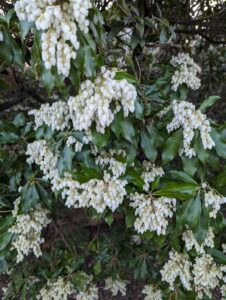 Real spring is days away, no matter what is happening with the weather. In the meantime, most of us celebrate the signs of the new season that are popping up everywhere. As the giant Dutch crocuses open their trumpets to blast the spring news, I pour used cat litter down the groundhog hole to let the resident ground hog know that this year I mean business. I take enormous pleasure in the opening of the first of many daffodils, knowing that even if I haven’t finished either last fall’s or this spring’s garden clean-up chores, the sight of the daffodils will sooth the bitter sting of guilt over my slothful ways.
Real spring is days away, no matter what is happening with the weather. In the meantime, most of us celebrate the signs of the new season that are popping up everywhere. As the giant Dutch crocuses open their trumpets to blast the spring news, I pour used cat litter down the groundhog hole to let the resident ground hog know that this year I mean business. I take enormous pleasure in the opening of the first of many daffodils, knowing that even if I haven’t finished either last fall’s or this spring’s garden clean-up chores, the sight of the daffodils will sooth the bitter sting of guilt over my slothful ways.
A sure sign of the end of winter is the appearance of flowers on the local Japanese pieris—Pieris japonica–or andromeda shrubs. Not everyone grows these beauties, which are part of the Ericaceae or heath family, but those that do are lucky. One of the most common nicknames for this useful plant is “lily-of-the-valley shrub” for the fragrant, bell, shaped flowers that dangle in opulently clustered racemes from the plants. When the bells open in earliest spring, they smell like honey—at least to my winter-weary nose. The bees, hungry at this time of year, like them too.
Traditionally those bells are either white or pale pink, but newer varieties, like Gay Goblin ‘Enchanted Forest’ feature darker pink flowers. All pieris blooms spring forth from slightly darker pink buds that appear on relatively large shrubs that may be as much as eight to ten feet tall and six to eight feet wide. If those dimensions are too large to earn pieris a place in your landscape, rest assured that plant breeders have already felt your pain and produced smaller varieties. Pieris save their best moves for spring, but put on a good show for the rest of the year as well. They are evergreen, with a dense growth habit that makes them useful as either specimen plants or hedges. The elongated, oval or lance-shaped leaves emerge with a dark red tint which turns into a shiny dark green as the season advances.
For those who routinely curse the shade on their properties, the news from the andromeda world is good. The shrubs will thrive in light to medium shade, but do prefer consistent moisture and the same acidic soil favored by heath family relatives like blueberries and mountain laurel. Pruning requirements are minimal, but if you want to keep the plant at a specific size or shape it attractively, do so just after the flowers fade in spring.
One of the most popular pieris is ‘Katsura’, a variety that sports the characteristic pale pink bells on plants that grow to a height of five feet. Monrovia, the major plant wholesaler that sells to many local retail nurseries, offers varieties from the trademarked Enchanted Forest series, including: white-flowered ‘River Nymph’; ‘Gay Goblin’; ‘Impish Elf’, which grows only three to five feet tall and wide and sprouts bright pink blooms; and white-flowered ‘Sunsprite’. Lovers of variegated leaves will gravitate to the slightly naughty-sounding Passion Party ‘Pink Frost’ with pale pink flowers and leaves edged with cream. If you crave drama, definitely check out ‘Mountain Fire’, a standard-size andromeda with especially red new growth that lights up early spring spaces.
If your garden is made up of containers, but you still pine for pieris, chose varieties like ‘Compacta’, which only grows three to four feet tall and can live happily in a large pot. The variegated ‘Little Heath’, sometimes called ‘L’il Heath’, is about the same size, but with the added attraction of bi-colored leaves. Remember that shrubs in large containers get especially thirsty during the dry summer months and need regular watering.
People sometimes think the evergreen realm is entirely populated by conifers, occasionally interrupted by overgrown rhododendrons. Nothing could be further from the truth and shrubs like andromeda prove the point nicely. Garden centers are stocking various varieties and sizes now. If you can’t find the ones you want, try The Tree Center, at (888) 329-0140 or www.thetreecenter.com.
Andromeda
↧
↧
Trending Articles
More Pages to Explore .....



















